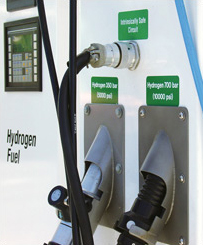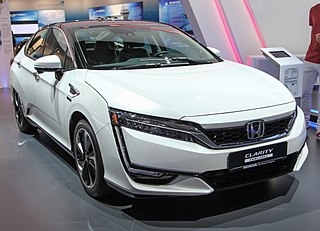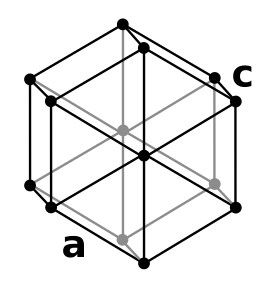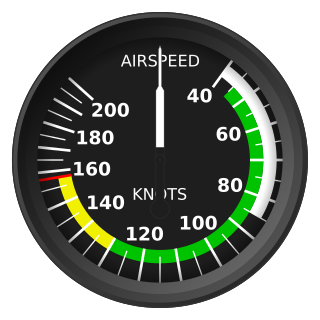Hydrogen fuel is a zero-emission fuel when burned with oxygen. It can be used in electrochemical cells or internal combustion engines to power vehicles or electric devices. It has begun to be used in commercial fuel cell vehicles such as passenger cars, and has been used in fuel cell buses for many years. It is also used as a fuel for the propulsion of spacecraft.

A fuel cell vehicle (FCV) or fuel cell electric vehicle (FCEV) is a type of electric vehicle which uses a fuel cell, instead of a battery, or in combination with a battery or supercapacitor, to power its on-board electric motor. Fuel cells in vehicles generate electricity to power the motor, generally using oxygen from the air and compressed hydrogen. Most fuel cell vehicles are classified as zero-emissions vehicles that emit only water and heat. As compared with internal combustion vehicles, hydrogen vehicles centralize pollutants at the site of the hydrogen production, where hydrogen is typically derived from reformed natural gas. Transporting and storing hydrogen may also create pollutants.

An autonomous underwater vehicle (AUV) is a robot that travels underwater without requiring input from an operator. AUVs constitute part of a larger group of undersea systems known as unmanned underwater vehicles, a classification that includes non-autonomous remotely operated underwater vehicles (ROVs) – controlled and powered from the surface by an operator/pilot via an umbilical or using remote control. In military applications an AUV is more often referred to as an unmanned undersea vehicle (UUV). Underwater gliders are a subclass of AUVs.

A hydrogen station is a storage or filling station for hydrogen, usually located along a road or hydrogen highway, or at home as part of the distributed generation resources concept. The stations are usually intended to power hydrogen vehicles, but can also be used to power small devices. Vehicles use hydrogen as fuel in one of several ways, including fuel cells and mixed fuels like HCNG. The hydrogen fuel dispensers dispense hydrogen gas by the kilogram.

The Honda Clarity is a nameplate used by Honda on alternative fuel vehicles. It was initially used only on hydrogen fuel-cell electric vehicles such as the 2008 Honda FCX Clarity, but in 2017 the nameplate was expanded to include the battery-electric Honda Clarity Electric and the plug-in hybrid electric Honda Clarity Plug-in Hybrid, in addition to the next generation Honda Clarity Fuel Cell.

The Monterey Bay Aquarium Research Institute (MBARI) is a private, non-profit oceanographic research center in Moss Landing, California. MBARI was founded in 1987 by David Packard, and is primarily funded by the David and Lucile Packard Foundation. Christopher Scholin serves as the institute's president and chief executive officer, managing a work force of approximately 220 scientists, engineers, and operations and administrative staff.

Methods of hydrogen storage for subsequent use span many approaches including high pressures, cryogenics, and chemical compounds that reversibly release H2 upon heating. Underground hydrogen storage is useful to provide grid energy storage for intermittent energy sources, like wind power, as well as providing fuel for transportation, particularly for ships and airplanes.
Hydrogen technologies are technologies that relate to the production and use of hydrogen. Hydrogen technologies are applicable for many uses.

The Toyota FCHV is a current hybrid hydrogen fuel cell vehicle development programme of the Toyota Motor Corporation, which was leased to a limited number of drivers in the United States and Japan beginning in 2002. "FCHV" stands for "Fuel Cell Hybrid Vehicle". A number of prototypes have been produced, up to the latest FCHV-adv ("advanced").

HydroGen3 is an Opel hydrogen fuel cell vehicle used for testing. HydroGen3’s 400-kilometer (250 mi) driving range is the highest of any fuel cell vehicle approved for public roads in Japan. The five seater front-wheel driven prototype is based on the Opel Zafira compact MPV.

The Type 925 Dajiang (大江) is a type of naval auxiliary ship belonging to the People's Republic of China. Each ship is usually equipped with up to two Type 7103 DSRV class Deep Submergence Rescue Vehicles (DSRVs). The lead ship of the Dajiang class is the Changxingdao. The Type 925 is a submarine tender that can also be used as a submarine rescue ship, and hence, it is designated as a submarine support ship by Chinese.
The Honda FCX is a family of hydrogen fuel cell automobiles manufactured by Honda.

The Railpower GG20BGreen Goat is a low-emissions diesel hybrid switcher locomotive built by Railpower Technologies Corp. It is powered by a single Caterpillar C9 six cylinder inline engine developing 300 horsepower (224 kW), which is also connected to a large battery bank where both sources combine for a total power output of 2,000 horsepower (1,490 kW). To date, there have been more than 50 GG20B electric-diesel electric hybrid switchers manufactured since their first introduction in 2004.

The Toyota Mirai is a mid-size hydrogen fuel cell car manufactured by Toyota, one of the first such sedan-like vehicles to be sold commercially. The Mirai was unveiled at the November 2014 Los Angeles Auto Show. As of December 2017, global sales totaled 5,300 Mirais. The top selling markets were the U.S. with 2,900 units, Japan with 2,100 and Europe with 200.

The Hyundai ix35 FCEV or Tucson FCEV is a hydrogen fuel cell electric vehicle developed by Hyundai. It is the first SUV-like vehicles to be sold commercially, as well as the first commercially mass-produced hydrogen fuel cell vehicle in the world. Different versions are known, the previous version was based on the Hyundai Tucson FCEV, and the upcoming model is based on the current ix35 FCEV. The first generation was introduced in 2001, with the Hyundai Santa Fe FCEV, and had a range of 100 miles (160 km), with a top speed of 78 mph (126 km/h).
















